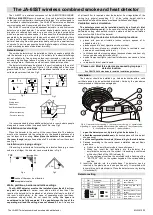
7
DMX-512 Control Mode
Fixtures require a "Start Address" from 1 to 512, setting the first DMX channel containing data for
the fixture (see DMX Background). Before addressing fixtures, consult the manual of the system’s
DMX controller to select a desirable addressing scheme. Valid Start Addresses range from 1 to
512. Fixtures requiring more than one channel for control will read subsequent channels up to the
total number of channels required. Since this fixture requires 12 channels maximum of DMX, if set
to a Start Address of 7 it would use data from channels: 7, 8, 9, 10, 11, 12, 13, 14, 15, 16, 17 and
18. Choose a Start Address so the channels used do not overlap with other fixtures. In some
cases, it may be desirable to set two or more same type fixtures to the same Start Address. In this
case, the fixtures will be slaved together and respond to the same data. Because all fixtures see
the same data, fixtures may be set to any address without concern for the physical order they are
connected by the DMX cables. This fixture has multiple DMX channel settings, 12 channels being
the maximum and offering the maximum controllability over the fixture. Other more conservative
DMX modes that use fewer DMX channels are available. All examples given are based on using
the maximum feature set of 12 DMX channels.
DMX Data Connection
This fixture uses 3 pin XLR type connectors and shielded twisted pair cable approved for
EIA-422/EIA485 use. Fixtures are connected in Daisy Chain topography: Connection is
made from the controller to the DMX-IN of the first light, then from the DMX-OUT to the
DMX-IN of the next light and so on. Only one data source can be on a chain and no
branching is allowed. The physical order in which the fixtures are connected is not
important, use the most convenient.
Data Terminator
A Data Terminator can be connected to the DMX-OUT of the last fixture
to reduce the effects of signal noise; it is not required for all installations.
To make a Terminator, connect a 120-ohm ¼ watt resistor across pin 2,
Data Negative (S-) and pin 3, Data positive (S+). A qualified technician
can determine if a Data Terminator is needed.
Adapter
5-to-3 pin
Systems using 5 pin DMX interfaces can be accommodated by purchasing 3-to-5 pin
adapters or building adapter cables. Numbers designating each pin can be found on
connectors. Converting between the two XLR types is done in a pin-to-pin fashion.
Connect the shields to pin 1, then connect pin 2 to pin 2 and pin 3 to pin 3, regardless of
either connector’s gender or pin count. No connection is made to Pins 4 & 5.
DMX-OUT
1
2
3
- Ground
- Signal (-)
- Signal (+)
XLR Connector - Socket:
DMX-IN
1
2
3
- Ground
- Signal (-)
- Signal (+)
XLR Connector - Plug:





























